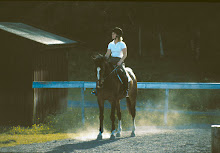
"A relaxed and happy horse" – that might have been the heading.
I have been a spectator to a two days seminar/training with Christoph Hess.
Mr. Hess is head of the training department of the German National Equestrian Federation, and an international dressage judge.
Being the dressage nerd I am, I try to get to all seminars within an acceptable distance.
I’ve been to clinics with Salzgeber, Ingrid Klimke, Kyrklund, Helgstrand, Hoyos, Balkenhol and more – but I wonder if not this clinic was the best.
Hess is a very sympathetic and knowledgeable trainer. I envied those riders that got the chance to train for him these two days!
But being a spectator was not bad either. It was definitely cheaper, lol!
Each day 8 riders participated.
The first day was “The training scale in practice” and the second day was “Program riding”.
I believe the first day was the most interesting one.
If I should do a sum up Mr. Hess' philosophy, it was that the base requirement was a relaxed and happy horse, which he always kept coming back to.
He worked much with stretching the horses in a deep form but with contact to the rein, to loosen the back (and no, no overbending!) and to always keep the horses truly in front of the leg.
I will try and share my notes of the sessions.
Please bear in mind that these are just my personal, subjective impressions, and take it just for that.

#1. Was a very beautiful, good moving “International small tour horse”
They started to work much with transitions halt-walk, and then halt-trot.
The horse was to answer forward, and the rider to soften the hands when doing upwards transitions.
Canter work. Medium canter along the long side, followed by shoulder-in in medium canter while giving the rein, both hands. Using medium canter as a tool to keep a true three-beat rhythm in the canter and to get the horse in front of the leg. He wanted the rider to stay up in a light seat in between, to facilitate more forward action with three beat canter and to get the horse’s back up.
They started to work much with transitions halt-walk, and then halt-trot.
The horse was to answer forward, and the rider to soften the hands when doing upwards transitions.
Canter work. Medium canter along the long side, followed by shoulder-in in medium canter while giving the rein, both hands. Using medium canter as a tool to keep a true three-beat rhythm in the canter and to get the horse in front of the leg. He wanted the rider to stay up in a light seat in between, to facilitate more forward action with three beat canter and to get the horse’s back up.
Then they started collected work in canter, with some pirouette work.
The rider was to take both reins in the outer hand, and decrease the circle gradually.
Mr. Hess did not worry about keeping the bend, the most important was self balance in the horse. He kept repeating “give both reins”. The rider was to look towards the centre of the circle to keep correct body posture.
Less hand, and get the horse truly in front of leg and in self balance was the goal.
The rider was to take both reins in the outer hand, and decrease the circle gradually.
Mr. Hess did not worry about keeping the bend, the most important was self balance in the horse. He kept repeating “give both reins”. The rider was to look towards the centre of the circle to keep correct body posture.
Less hand, and get the horse truly in front of leg and in self balance was the goal.
 #2. Was a GP horse, making the debut this year.
#2. Was a GP horse, making the debut this year.Not the best mover, but steady in the exercises.
It was not truly in front of the leg, so Mr Hess wanted more activity here.
They started out with warming up in trot and canter work at a forward tempo. Then shoulder-in at the long sides, still in a forward tempo with soft contact on the reins. Starting with half-pass and flying changes, Mr. Hess noted that problems with half-pass left and being one behind in one of the changes had the same cause, the horse did not truly respect the leg.
To solve this they started to work on diagonals, changing between half-pass, ride forward medium canter - half pass – medium canter. He made the point that this horse did not have a truly collected canter, just a slower one, and that this exercise would help.
Over to flying changes, one-tempi.
The horse was still one behind back in one of the changes, so he put them to this exercise: Medium canter through the short side, then going on the diagonal – 3 off three-tempi changes, medium canter again – new diagonal – 3 off tree-tempi changes.
He summed up that the horse needed to go more forward, and asked the rider to take off the spurs to next session. (Which was interesting)
 #3. Junior/advanced level horse, 17 yo.
#3. Junior/advanced level horse, 17 yo.Started out tense, and tensed up against the rider’s hand.
They started to work for quite a while in a long and low form, to get the horse to be “happy and relaxed”, with improved contact to the bit and better hind leg activity through a supple back. When starting canter work Mr. Hess wanted a transition to medium canter from the rider’s inside leg, but the horse did not react on this. He wanted the rider to soften on the contact on the inner rein, but pointed out that the horse must accept the aid from the inner leg.
He asked the rider to straighten up and look forward, and then proceeded to work with long and low form, collection by opening up the body in front without using reins. Transitions trot-canter-trot on the circle, again without touching the reins.
Mr Hess thought that the horse did not accept inside/outside leg enough, so they started to work with increasing/decreasing the circle to improve this.
The horse got more and more relaxed during the work, with much better hind leg activity/swinging more through the back in the end.
They continued same kind of work day two.

#4. Talented 8 yo GP-debuting horse
This horse and rider were working quite well, so Mr. Hess mainly concentrated upon seat and position. He wanted the horse to be a bit quicker behind, and that the rider should shorten the reins so the hand came more in front of him. He also wanted him to think of keeping the small fingers towards each other as the rider had a tendency to place the hands like riding a bike instead of holding a glass. In the work with half pass the rider had a tendency to sit to the outside, so they also worked on keeping the weight into the inside leg, and look in the direction of motion. When working with the flying changes the rider also was giving the signal with the leg placed too far back, this was also corrected.
Will be continued....(but without a murder)




























8 comments:
thanks for taking the time to write this up, wish we could have a natter over a glass of wine because the internet is too slow for true discussion, lol
I'm still saddened that an 8 yo is starting it's GP tour :-( hey ho, different world to mine.
Yes Trudi, I would love that!
Maybe share a bottle even, and really get the discussion going, LOL!
Still, what a wonderful thing internet is - without it we couldn't even share this, right?
I would like to share a bit more of your world though.
I have been thinking about your nice post on books. What would you recommend for me to read?
Mr Hess is a one great coach, there is a series of his dvds I once watched, very good. Lucky you to watch the seminar :) Looking forward to reading more of your notes!
Fabulous clinic report and thank goodness for the emphasis on self carriage and a softened hand - can't wait for the rest ( do you respect the leg enought Danni(our dressage horse) "I'll get back to you" Said Danni!)
Now HofC, I'm guessing you have already read plenty,hehe, but I'll put some thought to it.....OK thinking over.
Oliveira Nuno, Reflections....the thinking 'artwoman's handbook; you could lift literally dozens of quotes from this one.
Hempfling Klaus Ferdinand (one heluva scandi, lol), Dancing with horses...I'm not sure I like where he's gone nowadays but I love the concept and surely collection on a loose rein is one temptation I, for one, can't resist. It fires me up to want to achieve the almost impossible.
Anja Beran,Classical Schooling with the Horse in Mind (there is a more expensive one but it's basically all the same book, just a pricey one that was aims at the USA)
Udo Berger, The Way to Perfect Horsemanship...for me one of the first books I read not detailing 'how to' but 'why to' lots of pysiological stuff.
Paul Belasik...any of his as he has a thoughtful, artistic approach.
Oh gawd I could go on but you've probably read similar to me.
Ah just one last thought, read some Racinet, Jean Claude as against your germanic classical learning it will bring you up short and make you ask MANY questions of yourself. :-)
Thank you for taking the time to write this up - very interesting and informative!
Förstår att det var väldigt intressant att se o höra hans kommentarer. Skulle gärna också varit där!
Thanks for your comments, all!
Wiola - I will check up on the DVDs. Thanks for the tip!
Christine - Thanks! I just had to laugh reading your comment. My Fame is just like Danni...I got instant bad conscious hearing that comment over and over again at the seminar, and decided to improve once I got home training. Writing this down remined me again. Hehum.
And Trudi - Thanks!
I went out hacking just after reading you comment, and kept chuckling to myself all the way.
We have to have that red wine!
Oliveira, Beran, Berger, Belasik, I'll try and get them, but...NOT Hempling!(...you wanna have two ex? I'll send you one copy for free!)
And I will get Racinet too! Love questions!
Post a Comment